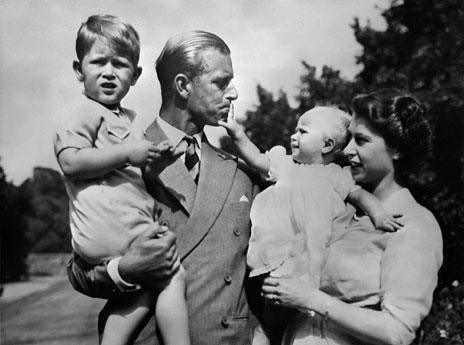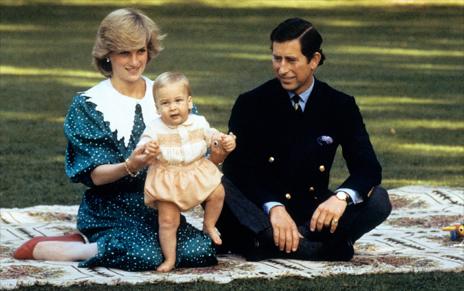Royal baby: Revolution in the nursery
- Published

Behind the walls of Kensington Palace, a revolution is taking place in the royal nursery, writes royal commentator Carolyn Harris. But how might the new royal baby's upbringing differ from that of his or her predecessors?
The Duke and Duchess of Cambridge have been quietly making plans for the future king or queen to receive a thoroughly modern upbringing. The baby's parents and grandparents will have more influence than any nannies might have, and both William and Catherine will balance royal duties with plenty of family time.
Previous generations of royalty introduced innovations to their nurseries but the royal couple enjoy an unprecedented amount of support from the public and the palace alike. They represent the future of the monarchy and their choices will shape popular attitudes toward both parenting and the royal family.
In January, they advertised for a general housekeeper, but not a nanny. This was interpreted by the media as a sign that they might intend being their child's primary caregivers.
The position, which was filled by the Queen's housemaid Antonella Fresolone in May, entails a diverse range of responsibilities including laundry, polishing silverware and walking the dog, as well as childcare.
When Prince Charles or even Prince William were children, numerous members of the royal household divided these duties between them.
The transformation of the royal nanny from the superintendent of the nursery to a part-time position is a break from tradition that reflects the Duke and Duchess of Cambridge's position in the 21st Century debate about "work-life balance".
The credentials and duties required of a royal nanny have changed considerably over the centuries. Charles I replaced his eldest son's first governess, the Countess of Roxburgh, when the Protestant public objected to a Roman Catholic raising the future Charles II.
By Queen Victoria's reign, royal nursemaids and governesses were expected to exercise complete authority in the nursery and devote themselves entirely to their charges with very little time for themselves.

The Queen and family in the 1950s
The degree of authority wielded by 19th and 20th Century nannies brought disaster for some royal children and comfort for others. As mentioned in the recent film, The King's Speech, the future Edward VIII and George VI were abused by one of their early nannies. But both Charles and William were close to their caregivers and found them to be sources of stability during difficult times.
By the time William and Harry were born, the traditional role of the royal nanny had become increasingly incompatible with the hands-on parenting style preferred by both the Prince and Princess of Wales.
Compared with the more formal approach favoured by the Queen and Prince Philip, both Charles and Diana embraced their children in public and took them on overseas royal tours from a young age. Diana reportedly thought William's first nanny, Barbara Barnes, was acting too much as a surrogate mother to the young prince - the accepted role for previous generations of royal nannies.

In New Zealand with Prince William
After the Prince and Princess of Wales separated in 1992, Charles hired an unconventional nanny, Tiggy Legge-Bourke, to help care for his sons. Rather than ruling a royal nursery, the youthful Legge-Bourke acted as a kind of older sister and friend to the princes, accompanying them on outings with their father. The combined nanny and housekeeper role created by William and Catherine continues this process of innovation in the royal nursery, replacing traditional nannies with part-time caregivers.
It is thought that the royal baby's grandparents will have more influence over his or her upbringing than any nanny, should they hire one. Catherine reportedly intends to spend the weeks following the birth with her parents, Michael and Carole Middleton. Before the 20th Century, British monarchs usually married foreign royalty, limiting the involvement of one set of grandparents in a royal child's life. When both sets of grandparents were close at hand, however, they all became involved in their grandchildren's upbringing.
Despite Diana's frequent conflicts with her family, William and Harry developed such a close relationship with their "Gran Fran" - Frances Shand Kydd - that Frances is one of the favourite names for the royal baby.
When the Queen was a child, trips to Scotland not only meant time at Balmoral with King George V and Queen Mary but visits to her Bowes-Lyon grandparents. Like Catherine, the woman who became known as the Queen Mother liked to have her parents close at hand during her confinements and gave birth to her second child, Princess Margaret, in the Bowes-Lyon residence, Glamis Castle.
There are numerous other signs that William and Catherine intend to follow in the footsteps of royal trailblazers rather than traditionalists. Prince Charles was the first royal father to be present in the delivery room since Queen Victoria's consort, Prince Albert, and there is every indication that William will do the same.
And 18th and 19th Century royal mothers courted controversy when they decided to breastfeed their children. Queen Marie Antoinette of France received a scolding letter from her mother when she decided to follow French Enlightenment parenting ideals and nurse her firstborn child. When Queen Victoria learned that her daughters were breastfeeding their own children, she named a cow in the royal dairy Princess Alice. Diana's decision to breastfeed her sons received praise from the public and Catherine will receive similar approval for being a modern royal mother.
The Duke and Duchess of Cambridge are part of a new generation of royal parents determined to balance their royal duties with a close relationship with their child. Their solution to the 21st Century problem of work-life balance is a hands-on approach to parenting with plenty of help from part time nannies and involved grandparents.
You can follow the Magazine on Twitter, external and on Facebook, external